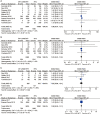Continuous-flow left ventricular assist device versus orthotopic heart transplantation in adults with heart failure: a systematic review and meta-analysis
- PMID: 33842215
- PMCID: PMC8033265
- DOI: 10.21037/acs-2020-cfmcs-fs-197
Continuous-flow left ventricular assist device versus orthotopic heart transplantation in adults with heart failure: a systematic review and meta-analysis
Abstract
Background: Due to the lack of donor hearts, many studies have assessed the prognosis of heart failure (HF) patients treated with a continuous-flow left ventricular assist device (CF-LVAD). However, previous results have not been consistent and minimal data is available regarding long-term outcomes. There is no consensus on whether CF-LVAD as a bridge or destination therapy (DT) can equal orthotopic heart transplantation (HTx). The purpose of our study is to compare clinical outcomes between CF-LVAD and HTx in adults.
Methods: We searched controlled trials from PubMed, Cochrane Library, and Embase databases until July 1, 2020. The mortality at different time points and adverse events were analyzed among 12 included studies.
Results: No significant differences were found in mortality at one-year [odds ratio (OR) =1.08; 95% CI: 0.97-1.21], two-year (OR =1.01; 95% CI: 0.91-1.12), three-year (OR =1.02; 95% CI: 0.69-1.51), and five-year (OR =1.02; 95% CI: 0.93-1.11), as well as the comparison of stroke, bleeding, and infection between CF-LVAD as a bridge versus HTx. The pooled analysis of one-year mortality (OR =2.76; 95% CI: 0.38-20.18) and two-year mortality (OR =1.64; 95% CI: 0.22-12.23) revealed no significant difference between CF-LVAD DT and HTx. Comparisons of adverse events showed no differences in bleeding or infection, but a higher risk of stroke (OR =5.09; 95% CI: 1.74-14.84) for patients treated with CF-LVAD DT than with HTx.
Conclusions: CF-LVAD as a bridge results in similar outcomes as HTx within five years. CF-LVAD as a DT is associated with similar one-year and two-year mortality, but carries a higher risk of stroke, as compared with HTx.
Keywords: Heart failure (HF); bridge to transplantation (BTT); continuous-flow left ventricular assist device (CF-LVAD); destination therapy (DT); heart transplantation (HTx).
2021 Annals of Cardiothoracic Surgery. All rights reserved.
Conflict of interest statement
Conflicts of Interest: The authors have no conflicts of interest to declare.
Figures





Similar articles
-
A prospective comparison of mid-term outcomes in patients treated with heart transplantation with advanced age donors versus left ventricular assist device implantation.Interact Cardiovasc Thorac Surg. 2016 Oct;23(4):584-92. doi: 10.1093/icvts/ivw164. Epub 2016 May 30. Interact Cardiovasc Thorac Surg. 2016. PMID: 27245619
-
Heart transplantation versus left ventricular assist devices as destination therapy or bridge to transplantation for 1-year mortality: a systematic review and meta-analysis.Ann Cardiothorac Surg. 2018 Jan;7(1):3-11. doi: 10.21037/acs.2017.09.18. Ann Cardiothorac Surg. 2018. PMID: 29492379 Free PMC article. Review.
-
Contemporary outcomes of continuous-flow left ventricular assist devices-a systematic review.Ann Cardiothorac Surg. 2021 Mar;10(2):186-208. doi: 10.21037/acs-2021-cfmcs-35. Ann Cardiothorac Surg. 2021. PMID: 33842214 Free PMC article.
-
Results of new-generation intrapericardial continuous flow left ventricular assist devices as a bridge-to-transplant.J Cardiovasc Med (Hagerstown). 2018 Dec;19(12):739-747. doi: 10.2459/JCM.0000000000000721. J Cardiovasc Med (Hagerstown). 2018. PMID: 30300244
-
Ventricular arrhythmias following continuous-flow left ventricular assist device implantation: A systematic review.Artif Organs. 2020 Aug;44(8):E313-E325. doi: 10.1111/aor.13665. Epub 2020 Mar 8. Artif Organs. 2020. PMID: 32043582
Cited by
-
Pectus Excavatum and Risk of Right Ventricular Failure in Left Ventricular Assist Device Patients.Rev Cardiovasc Med. 2023 Nov 9;24(11):313. doi: 10.31083/j.rcm2411313. eCollection 2023 Nov. Rev Cardiovasc Med. 2023. PMID: 39076441 Free PMC article.
-
Impact of Left Ventricular Assist Devices on Days Alive and Out of Hospital in Hemodynamically Stable Patients with End-Stage Heart Failure: A Propensity Score Matched Study.Life (Basel). 2022 Nov 24;12(12):1966. doi: 10.3390/life12121966. Life (Basel). 2022. PMID: 36556331 Free PMC article.
-
Upgrading extra corporeal life support to ECMELLA using Impella 5.0 in rescued INTERMACS 1 patients, lactate level matters!J Thorac Dis. 2023 Jun 30;15(6):3079-3088. doi: 10.21037/jtd-22-1297. Epub 2023 May 9. J Thorac Dis. 2023. PMID: 37426165 Free PMC article.
-
Clinical practice guidelines for diagnostic and treatment of the chronic heart failure.Arch Cardiol Mex. 2024;94(Supl 1):1-74. doi: 10.24875/ACM.M24000095. Arch Cardiol Mex. 2024. PMID: 38648647 Free PMC article. English.
References
-
- Ponikowski P, Voors AA, Anker SD, et al. 2016 ESC Guidelines for the diagnosis and treatment of acute and chronic heart failure: The Task Force for the diagnosis and treatment of acute and chronic heart failure of the European Society of Cardiology (ESC)Developed with the special contribution of the Heart Failure Association (HFA) of the ESC. Eur Heart J 2016;37:2129-200. 10.1093/eurheartj/ehw128 - DOI - PubMed
LinkOut - more resources
Full Text Sources
Other Literature Sources
Research Materials
Miscellaneous
